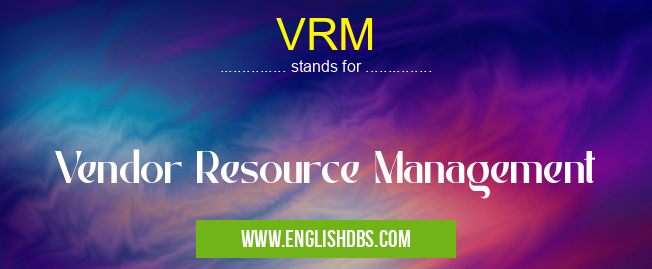What does VRM mean in MANAGEMENT
VRM is an essential aspect of modern supply chain management. By effectively managing vendor relationships, businesses can optimize costs, reduce risks, improve quality and efficiency, and drive innovation. A well-executed VRM strategy not only enhances organizational performance but also fosters a mutually beneficial collaboration between businesses and their vendors.

VRM meaning in Management in Business
VRM mostly used in an acronym Management in Category Business that means Vendor Resource Management
Shorthand: VRM,
Full Form: Vendor Resource Management
For more information of "Vendor Resource Management", see the section below.
» Business » Management
Objectives of VRM
- Cost Optimization: Negotiate favorable pricing, identify cost-saving opportunities, and streamline procurement processes.
- Risk Mitigation: Assess and manage potential risks associated with vendors, such as financial instability, quality issues, or supply chain disruptions.
- Improved Quality and Efficiency: Collaborate with vendors to enhance product or service quality, streamline delivery timelines, and reduce operational inefficiencies.
- Innovation and Collaboration: Foster open communication and encourage vendor involvement in product or process development, leading to innovation and improved outcomes.
- Compliance and Sustainability: Ensure that vendors align with organizational policies and regulatory requirements related to environmental sustainability, ethical sourcing, and labor practices.
Key Elements of VRM
- Vendor Assessment and Selection: Thoroughly evaluate potential vendors based on criteria such as capabilities, financial stability, and quality standards.
- Contract Management: Negotiate and manage contracts that clearly define roles, responsibilities, deliverables, and performance expectations.
- Performance Monitoring: Regularly assess vendor performance against agreed-upon metrics to identify areas for improvement.
- Vendor Development: Provide support and guidance to vendors to enhance their capabilities, foster collaboration, and drive continuous improvement.
- Risk Management: Implement strategies to mitigate potential risks associated with vendors, such as diversification of supply sources or contingency planning.
Conclusion:
Essential Questions and Answers on Vendor Resource Management in "BUSINESS»MANAGEMENT"
What is Vendor Resource Management (VRM)?
Vendor Resource Management (VRM) is the strategic process of managing and optimizing relationships with external vendors to achieve business objectives. Its purpose is to ensure that vendors provide the necessary goods, services, or expertise while maximizing value and minimizing risks.
What are the key benefits of VRM?
VRM offers several benefits, including:
- Improved vendor performance and reliability
- Reduced costs through efficient vendor selection and negotiation
- Enhanced supply chain visibility and control
- Increased compliance with regulatory and ethical standards
- Access to specialized expertise and innovation
What is the role of technology in VRM?
Technology plays a crucial role in VRM by:
- Automating tasks and streamlining processes
- Providing real-time visibility into vendor performance
- Facilitating collaboration and communication
- Enabling data-driven decision-making
How can VRM help businesses achieve their sustainability goals?
VRM can support sustainability initiatives by:
- Identifying and partnering with vendors that prioritize environmental and social responsibility
- Monitoring vendor compliance with sustainability standards
- Promoting sustainable practices throughout the supply chain
What are the best practices for effective VRM?
Best practices for VRM include:
- Establishing clear vendor selection criteria
- Conducting thorough vendor due diligence
- Developing robust vendor contracts
- Monitoring vendor performance regularly
- Fostering open and collaborative relationships with vendors
